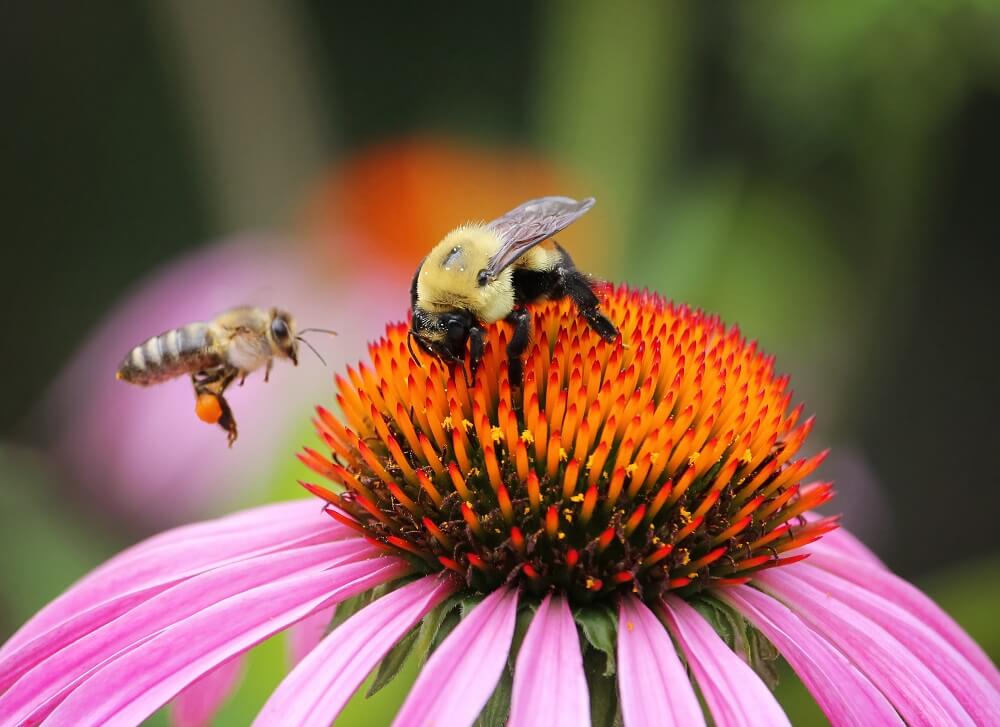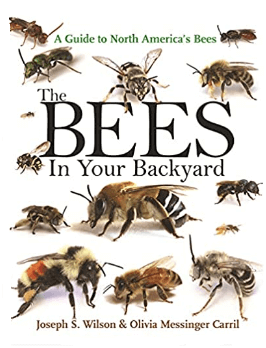Honey Bees vs. Bumble Bees:

| Honey Bee | Bumble Bee | |
|---|---|---|
| Appearance | Thin with little fuzz | Large and “fuzzy” |
| Lifespan | 2-4 years (queen) | 1 year (queen) |
| Honey | Produces high quantities of honey | Produces small quantities of honey |
| Sting | Can only sting once before dying | Can sting many times without dying |
| Colony size | 20,000 – 60,000 bees | 50 – 500 bees |
| Nature | Generally passive | Generally passive |
| Winter | Doesn’t hibernate | Does hibernate |
| Pollination | Less efficient pollinators (per bee) | More efficient pollinators (per bee) |
| Species total | 8 species | Over 250 species |
| Nesting | Above ground | Under ground |
Honey Bee vs. Bumble Bee: Appearance
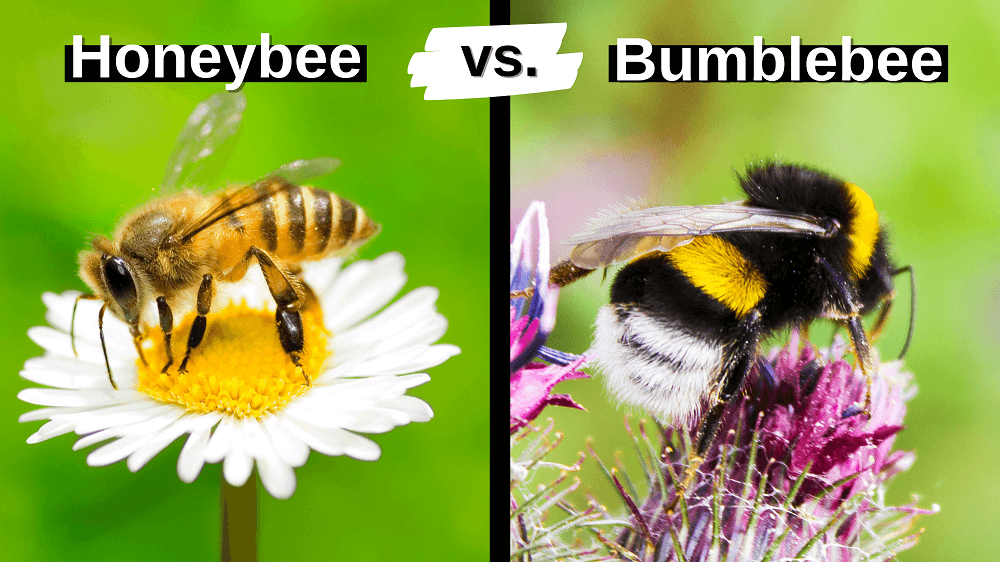
People sometimes ask:
Are bumble bees and honey bees the same?
No, they’re different species of bees but they do belong to the same bee family (Apidae).
Honey bees are thinner and smaller, while bumble bees are fuzzier and larger. Bumble bees are easy to spot because of their size. In fact, queen bumble bees and carpenter bees are the largest native bees in the US.(1, 2)
But here’s the tricky part:
Honey bees are sometimes mistaken for wasps because they have a similar shape and size.
But look closely:
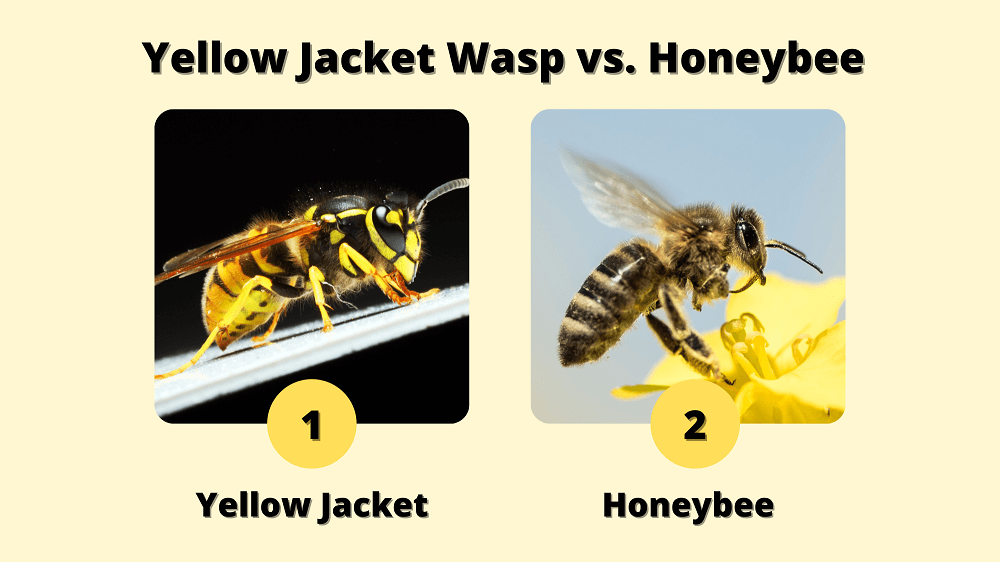
Notice how the wasp has a more vibrant yellow color?
Honey bees are easy to identify once you know what to look for.
Another important difference between honey bees and bumble bees is their body structure. The head and abdomen of honey bees are distinct, while bumble bees are “all one piece.”
Check it out:
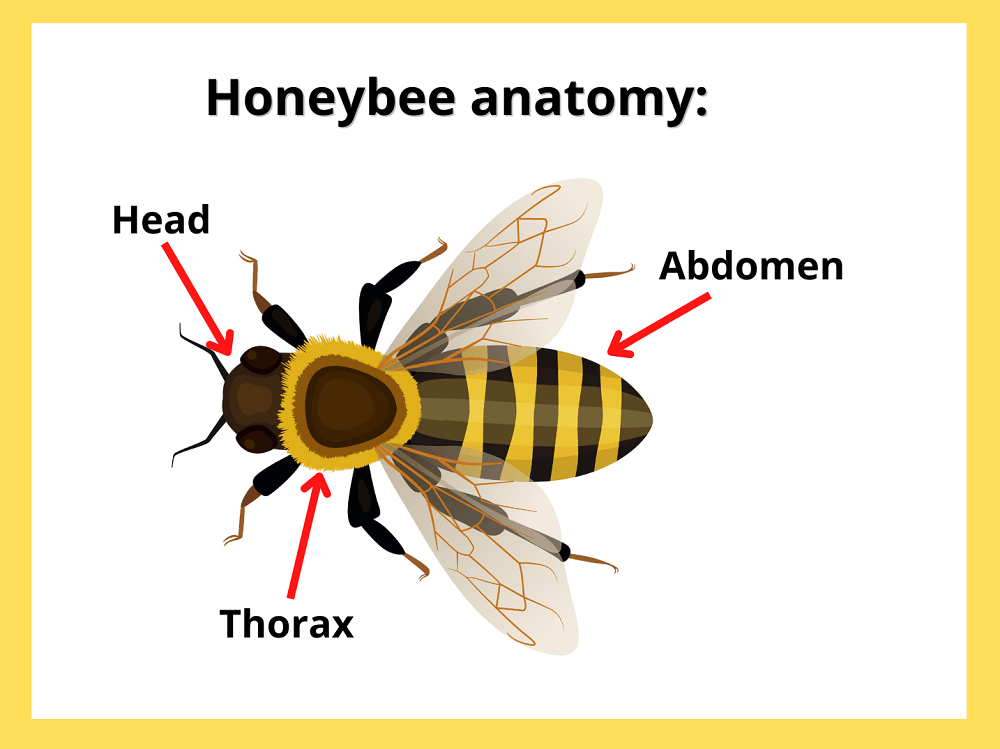
As for similarities between honey bees and bumble bees?
They both have:
- Six legs
- Five eyes
- Four wings
- Two antennas
Pretty cool, right?
Now let’s move on to their lifespans.
Honey Bee vs. Bumble Bee: Lifespan
| Honey Bee | Bumble Bee | |
|---|---|---|
| Queen | 2-4 years | 1 year |
| Worker (female) | 6-24 weeks | 4 weeks |
| Drone (male) | 55 days | 14 days |
Queen Bees Lifespan
The queen honey bee lives 2 to 4 years while the queen bumble bee lives 1 year. Both queen honey bees and bumble bees are well taken care of by their worker bees. They’re fed, cleaned, and protected 24/7.
And because the queen bees don’t venture outside of the hive as much, their wings and bodies don’t deteriorate as quickly as the worker bees.
But that said?
All good things come to an end. The queen bees don’t live forever.
For queen honey bees, their pheromone and egg-laying capabilities decrease as they age. When a queen honey bee starts declining, the worker bees will raise a new queen to replace her.
Bumble bee queens are different.
They only live one year. New bumble bee queens are born in the late summer as the old queen passes away.
Worker Bees Lifespan
Worker bees are exclusively female bees that, you guessed it, do the work for the hive. Some of their duties include:
- Cleaning the hive
- Protecting the hive
- Raising baby bees
- Tending to the queen
- Gathering food
- Making honey
So how does the worker lifespan differ between honey bees and bumble bees?
A worker bumble bee can live anywhere from 3-12 weeks. Four weeks is considered the average lifespan.(3)
In contrast, the lifespan of a honey bee worker is determined by the season she was born.
- The lifespan of worker bees born in the spring & summer: 6 weeks
- The lifespan of worker bees born in the fall: up to 6 months
So, you may be wondering:
Why does a worker honey bee’s lifespan vary based on the season it was born?
It’s because worker bees born in the spring and summer have more active lives. As a result, the work takes a toll on their wings and bodies because spring and summer are peak seasons.
In contrast, fall-born worker honey bees have a very different lifestyle from spring-born worker bees. Their main priority is preparing for winter and raising the new generation of bees for spring. Overall, the fall season is less taxing on their bodies and allows them to live longer.
Drone Bees Lifespan
Males are known as drone bees, and they are the shortest-lived members of the colony.(4, 5)
- The average lifespan of a drone honey bee is 55 days.
- The average lifespan of a drone bumble bee is 14 days.
Drone honey bees die after mating, while drone bumble bees don’t. Male bumble bees can mate several times.
Honey Bee vs. Bumble Bee: Honey
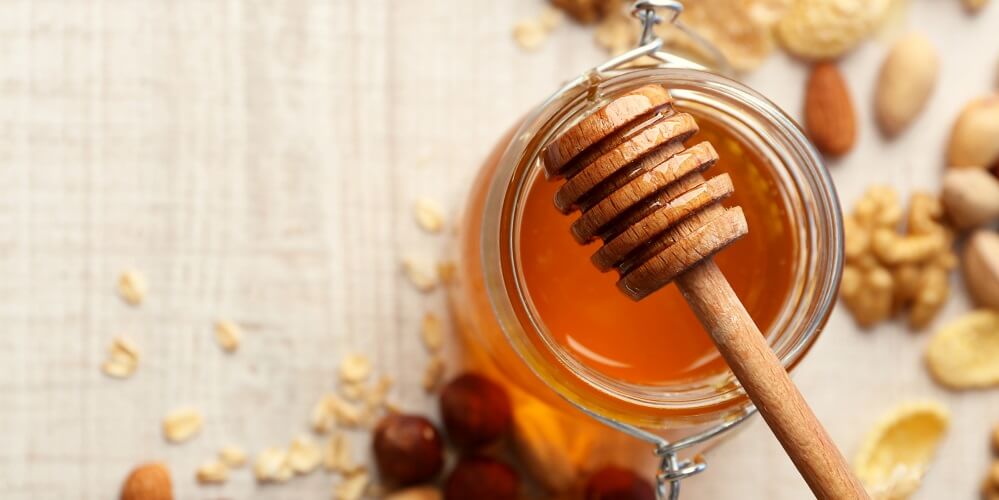
Most people don’t realize that bumble bees make honey.
But here’s the thing:
Bumble bees don’t make nearly as much honey as honey bees do.
A healthy honey bee colony can produce up to 100 pounds of honey per year. They use it to feed on during the winter months when no flowers are blooming.
Bumble bees only make a couple of tablespoons of honey – just enough to survive when nectar sources are low. Also, bumble bees don’t need honey storage during the winter.
Why?
Because only the queen bumble bee survives the winter because she hibernates. The rest of the colony dies. While the queen bumble bee hibernates, she doesn’t eat or work so there’s no need for honey.
Honey Bee vs. Bumble Bee: Sting
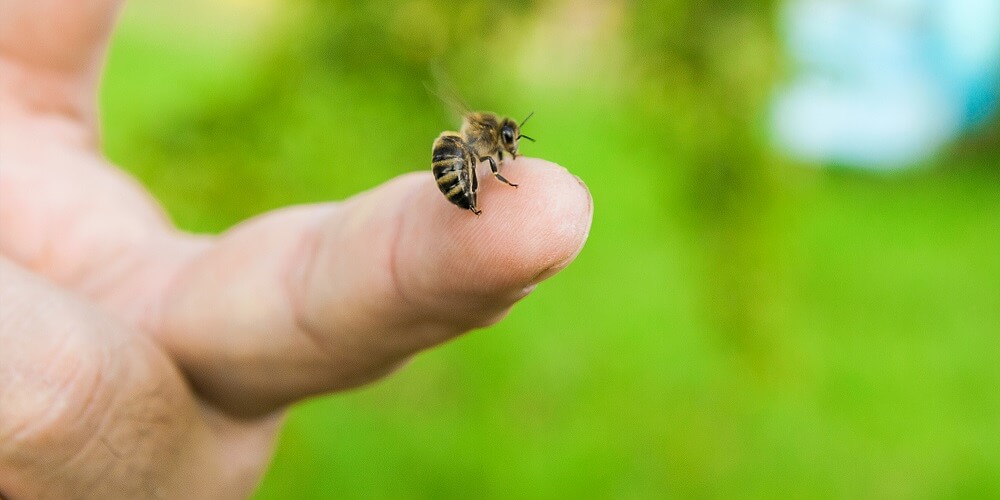
Here’s a not-so-fun fact:
Honey bees are the only bees that die after stinging.
How come, you ask?
A honey bee’s stinger is barbed, meaning it “hooks” into the skin. So once the honey bee flies away, it leaves behind its stinger.
The only problem?
A honey bee’s stinger is part of its digestive tract, plus nerves and muscles. So when the stinger gets hooked into the skin, it pulls out the bee’s essential organs along with it. This is what kills the honey bee.
Bumble bees have smooth stingers that don’t get stuck in your skin. So bumble bees can safely sting several times without getting hurt.
Honey Bee vs. Bumble Bee: Colony Size

Both honey bees and bumble bees are social bees that live in colonies. Each member has assigned roles: the queen bee, worker bees, and drone bees.(6)
The biggest difference between their colonies is the size.
A healthy honey bee colony can have more than 60,000 bees in it. When a honey bee colony gets too large to the point of overcrowding, the colony will divide in half. This is called swarming and it means half the colony leaves with the old queen to find a new home.
Bumble bee colonies are much smaller, ranging from 50 to 500 bees on average. Bumble bee colonies don’t swarm.
Honey Bee vs. Bumble Bee: Temperament
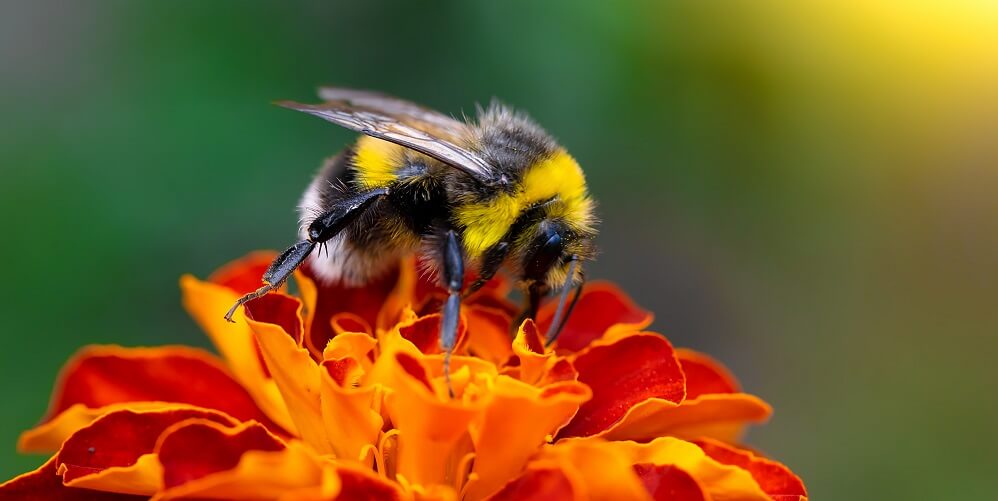
Let me start by saying this:
All bees have “good” and “bad” days.
For example, cloudy and windy weather can upset bees. Also, if they lose a queen unexpectedly, it can send them into a panic.
But mostly?
Bees have more good days than bad. They generally prefer sunny and warm weather to forage and go about their daily duties. Most bees are typically docile, and they’ll leave you alone as long as you leave them alone.
There are exceptions to this, of course.
But, for the most part, honey bees and bumble bees both have passive temperaments as long as they don’t feel threatened.
Honey Bee vs. Bumble Bee: Hibernation
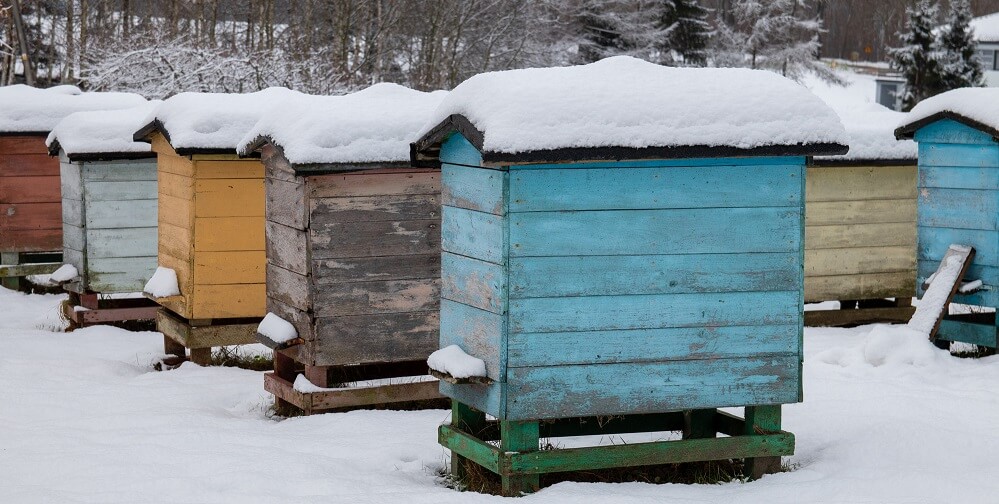
The honey bee and bumble bee difference become apparent during the winter.
Honey bees will stay in their hives all winter, keeping them warm and safe. Honey bees must huddle together closely to keep warm (and alive) in the winter since there are no blankets, fires, or adjustable thermostats.
Honey bees start clustering when winter temperatures drop below 57 °F (14 °C).(7)
Although a winter honey bee colony is much smaller than a summer one, it’ll still contain several thousand bees. During the winter, they eat and work, which requires an ample supply of honey to survive.
Bumble bees don’t live in colonies over the winter.
Instead, new bumble bee queens hatch in the summer while the old queen dies off.
Each new queen bumble bee will mate and then find a safe wintering location. This is typically just a tiny hole in the ground or another secure location with enough space just for her. The queen bumble bees hibernate until spring while the rest of the colony dies.
While the queen bumble bee hibernates, she’s neither eating nor working. Her decreased metabolic rate allows her to survive the winter without burning much energy.
Honey Bee vs. Bumble Bee: Pollination
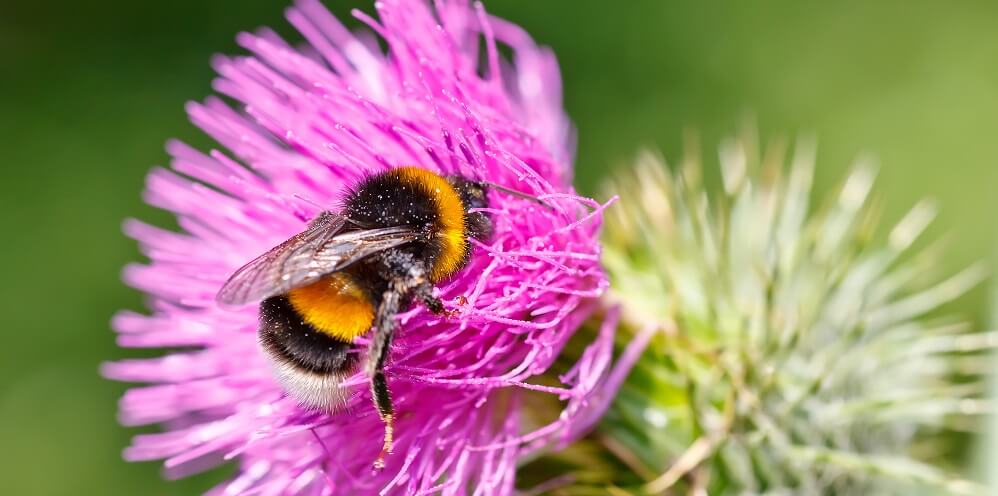
There are key differences in the way bumble bees and honey bees pollinate. Here are a few:
- Bumble bees become active at temperatures near 40°F (5°C), honey bees become active at temperatures near 60°F (15°C).
- Bumble bees remain active on rainy, cloudy, and overcast days. Honey bees are less active during overcast days because they prefer sunny weather.
- Bumble bees use a technique known as “buzz pollination” to help them pollinate flowers. A bumble bee’s rapid vibrating motion allows it to collect and remove large amounts of pollen from a flower. In turn, this allows bumble bees to pollinate a flower in one visit. Before a honey bee can fully pollinate a flower, it generally needs to visit the flower several times.
- Bumble bees don’t have a sophisticated communication system like honey bees, so they’re less likely to fly away for more attractive blooms.
- Bumble bees, unlike honey bees, are drawn to blooms with narrow corolla tubes, such as blueberries and cranberries.
- Bumble bees are far more effective pollinators than honey bees. They specialize in gathering pollen rather than nectar, and each trip delivers greater amounts of pollen to the pistils.
- Bumble bees increase cross-pollination rates because they forage between plants more randomly than honey bees.
- Bumble bees visit more blossoms in a minute than honey bees.
- Bumble bees work longer – starting earlier in the morning and staying later into the evening hours.
- Honey bees are easier to move and place near crops that need pollination. This is why they’re popular amongst farmers and gardeners.
Honey Bee vs. Bumble Bee: Species Total
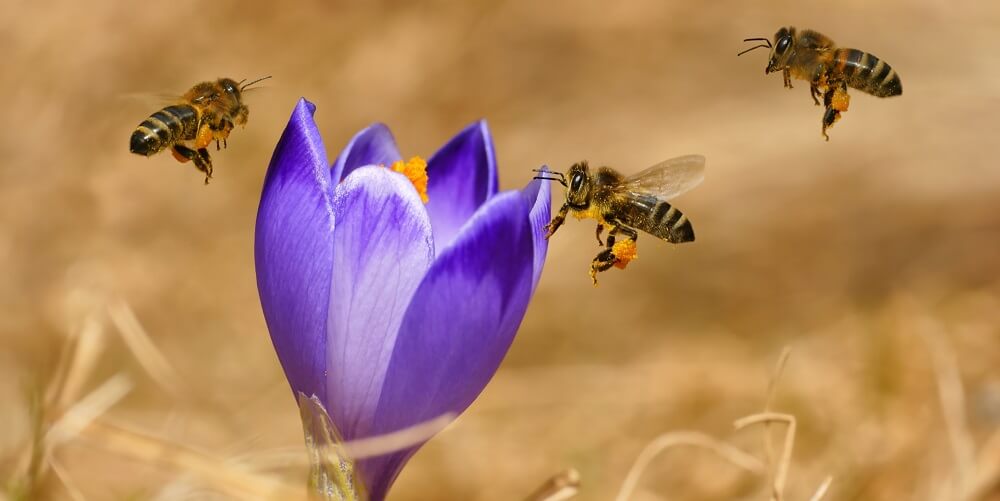
If you’ve ever asked, “What’s the difference between honey bees and bumble bees?” you’ll notice a big difference in their species size.
There are over 250 species of bumble bees worldwide. The various species don’t differ greatly in their appearance, except for their coloring.(8, 9)
The United States is home to 49 species of bumble bees. These species can be divided into three classes based on tongue length: short, medium, and long.(10)
Different species of bumble bees may visit different sizes and forms of flowers due to the variation in tongue size.
There are only eight species of honey bees. The western honey bee (Apis mellifera) is the most well-known honey bee, having been used for honey production and crop pollination.
The eastern honey bee (Apis cerana) is another popular honey bee that lives in South Asia.
Honey Bee vs. Bumble Bee: Nesting

Honey bees build a large colony out of wax combs for their young.
Hives of “wild” honey bees are typically found in hollow trees or logs, although they may also be found in attics and wall voids. Some colonies will contain as many as 20,000 to 60,000 honey bees.
When a honey bee hive is overcrowded, the bees begin creating new queens.
In some cases, drones (male bees) are also raised. When the new queen is close to emerging, the old queen will depart with thousands of worker bees. This large group of bees is called a swarm, and their purpose is to find a new place to form a hive.
Swarms of bees will sometimes stay in open locations like trees and shrubs before settling on a new home. Often, these swarms appear and vanish in a single day.
Bumble bees, like honey bees, may be found in social colonies made up of a queen bee, female ‘worker’ bees, and male drones. The colonies are annual, which means they live for one year only.
Bumble bee colonies usually have between 50 to 500 bumble bees in them.
In the spring, the queen bumble bee emerges from her nest and begins looking for nectar and pollen to restore her energy and fat stores.
The queen will then spend several days looking for a nest site. Bumble bees most frequently make nests in preexisting cavities on the ground, such as rock piles, empty mouse burrows, and beneath thick vegetation layers.
Once she’s found a nesting site, the queen bumble bee will build a few wax pots that she fills with nectar and pollen. Then she’ll lay her eggs on top.
The queen will lay several eggs over the next six weeks, and if everything goes according to plan, several healthy worker bees will hatch. Once the workers hatch, the queen focuses on laying eggs rather than foraging.
Eventually, the old queen and worker bumble bees will die off before winter. New queen bumble bees hatch in the summer, and they search for a safe spot to hibernate during the winter.
